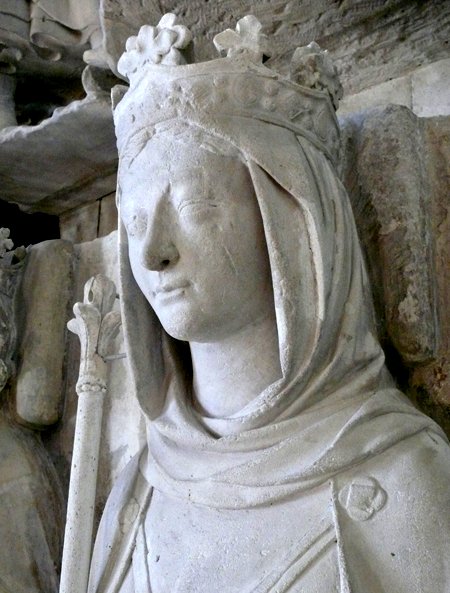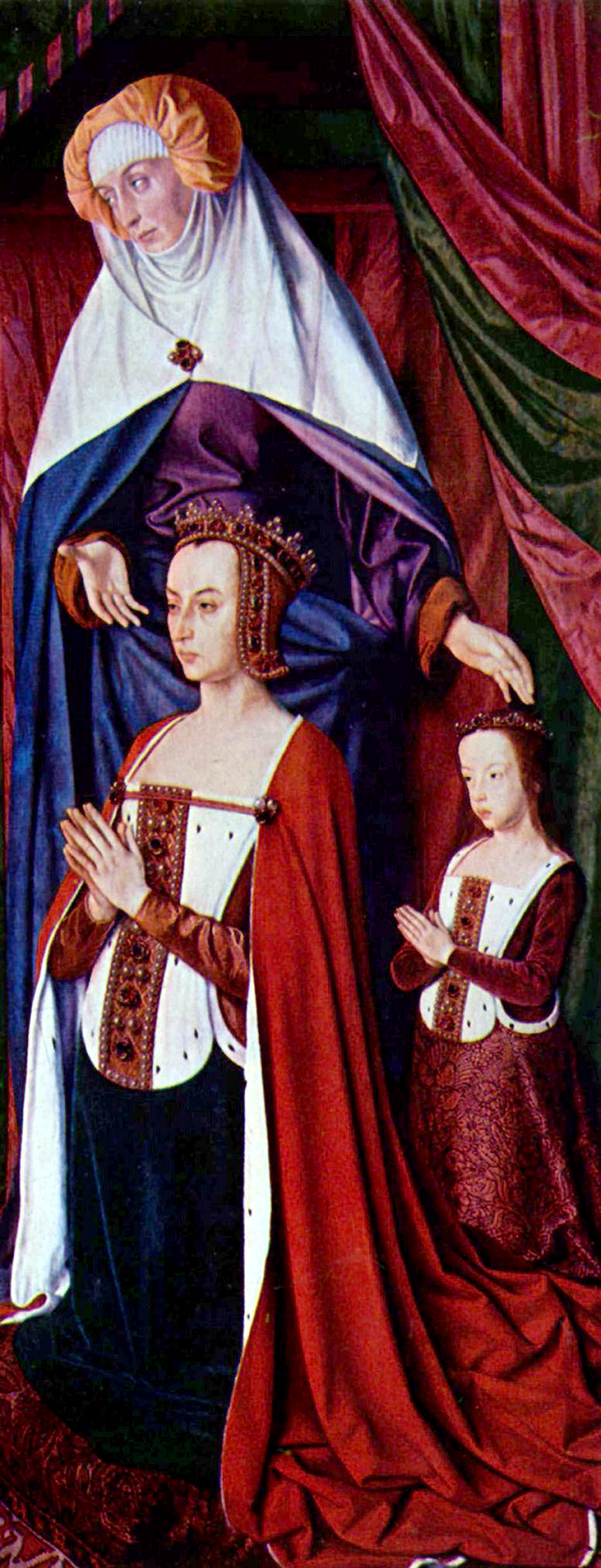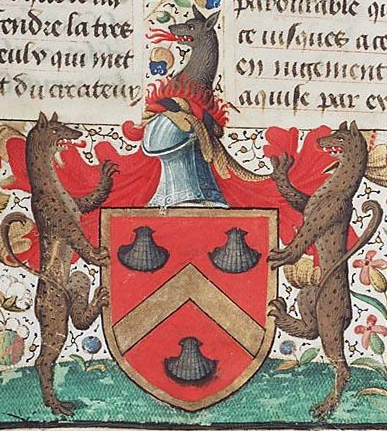|
Charlotte Of Savoy
Charlotte of Savoy (16 November 1441 – 1 December 1483) was Queen of France as the second spouse of Louis XI. She served as regent during the king's absence in 1465, and was a member of the royal regency council during her son's minority in 1483. Life She was a daughter of Louis, Duke of SavoyJoachim W. Stieber, ''Pope Eugenius IV, the Council of Basel and the Secular and Ecclesiastical Authorities in the Empire'', (E.J. Brill, 1978), 254. and Anne of Cyprus.Sharon L. Jansen, ''Anne of France: Lessons For My Daughter'', ed. Jane Chance, (Boydell & Brewer, 2004), 2-3 She was one of 19 children, 14 of whom survived infancy. Marriage On 11 March 1443, when Charlotte was just over a year old, she was betrothed to Frederick of Saxony (28 August 1439- 23 December 1451), eldest son of Frederick II, Elector of Saxony. The betrothal did not lead to a marriage, however, was annulled for reasons unknown. The younger Frederick died at the age of 12. On 14 February 1451, 10 months befo ... [...More Info...] [...Related Items...] OR: [Wikipedia] [Google] [Baidu] |
Queen Consort Of France
This is a list of the women who were queen consort, queens or empresses as wives of List of French monarchs, French monarchs from the 843 Treaty of Verdun, which gave rise to West Francia, until 1870, when the French Third Republic was declared. Living wives of reigning monarchs technically became queen consorts, including Margaret of Burgundy, Queen of France, Margaret of Burgundy and Blanche of Burgundy who were kept in prison during their whole queenships. Carolingian dynasty (751-987) Capetian dynasty (987-1792, 1814-1815, 1815-1848) Direct Capetians (987-1328) House of Valois (1328-1589) House of Lancaster Some sources refer to Margaret of Anjou as Queen of France,Mary Ann Hookham: "The life and times of Margaret of Anjou, queen of England and France ", 1872 but her right to enjoy that title is disputed. She was briefly recognized only in English-controlled territories of France. (See also: Dual monarchy of England and France) Capetian dynasty House of Va ... [...More Info...] [...Related Items...] OR: [Wikipedia] [Google] [Baidu] |
Isabella Of Bourbon
Isabella of Bourbon, Countess of Charolais (c. 1434 – 25 September 1465) was the second wife of Charles the Bold, Count of Charolais and future Duke of Burgundy. She was a daughter of Charles I, Duke of Bourbon and Agnes of Burgundy, and the mother of Mary of Burgundy, heiress of Burgundy. Life Not much is known about Isabella's life. She was the daughter of the reigning Duke of Bourbon, and his Burgundian wife, Agnes, daughter of John the Fearless, the powerful Duke of Burgundy. Although her father was politically opposed to his brother-in-law, Philip the Good, he betrothed Isabella to Charles the Bold, only legitimate son and heir of Burgundy as a condition of truce. She married Charles on 30 October 1454 at Lille, France, and they were reportedly very much in love, perhaps because of (or causing) her husband's faithfulness. In 1459, Isabella stood godmother to Joachim, the short-lived son of the refugee Dauphin of France and his second wife, Charlotte of Savoy. ... [...More Info...] [...Related Items...] OR: [Wikipedia] [Google] [Baidu] |
List Of Queens And Empresses Of France
This is a list of the women who were queens or empresses as wives of French monarchs from the 843 Treaty of Verdun, which gave rise to West Francia, until 1870, when the French Third Republic was declared. Living wives of reigning monarchs technically became queen consorts, including Margaret of Burgundy and Blanche of Burgundy who were kept in prison during their whole queenships. Carolingian dynasty (751-987) Capetian dynasty (987-1792, 1814-1815, 1815-1848) Direct Capetians (987-1328) House of Valois (1328-1589) House of Lancaster Some sources refer to Margaret of Anjou as Queen of France,Mary Ann Hookham: "The life and times of Margaret of Anjou, queen of England and France ", 1872 but her right to enjoy that title is disputed. She was briefly recognized only in English-controlled territories of France. (See also: Dual monarchy of England and France) Capetian dynasty House of Valois House of Bourbon (1589-1792) Françoise d'Aubigné, Marquise de M ... [...More Info...] [...Related Items...] OR: [Wikipedia] [Google] [Baidu] |
Duke Of Berry
Duke of Berry () or Duchess of Berry () was a title in the Peerage of France. The Duchy of Berry, centred on Bourges, was originally created as an appanage for junior members of the French royal family and was frequently granted to female royals. The style "Duke of Berry" was later granted by several Bourbon monarchs to their grandsons. The last official Duke of Berry was Charles Ferdinand of Artois, son of Charles X. The title Duke of Berry is currently being claimed through its usage as a courtesy title by Prince Alphonse de Bourbon, son of Prince Louis, Duke of Anjou, the Legitimist claimant to the French Throne. House of Valois (1360-1505) On October 1360, King John II created the peerage-duchy of Berry as an appanage for his third-born son, John of Poitiers, perhaps on the occasion of his marriage with Joan of Armagnac. Upon his death in 1416, John of Poitiers was succeeded as Duke of Berry by his grandnephew John, Dauphin of France (having been predeceased in 1397 b ... [...More Info...] [...Related Items...] OR: [Wikipedia] [Google] [Baidu] |
Louis XII Of France
Louis XII (27 June 14621 January 1515), also known as Louis of Orléans was King of France from 1498 to 1515 and King of Naples (as Louis III) from 1501 to 1504. The son of Charles, Duke of Orléans, and Marie of Cleves, he succeeded his second cousin once removed and brother-in-law, Charles VIII, who died childless in 1498. Louis was the second cousin of King Louis XI, who compelled him to marry the latter's disabled and supposedly sterile daughter Joan. By doing so, Louis XI hoped to extinguish the Orléans cadet branch of the House of Valois. When Louis XII became king in 1498, he had his marriage with Joan annulled by Pope Alexander VI and instead married Anne, Duchess of Brittany, the widow of Charles VIII. This marriage allowed Louis to reinforce the personal Union of Brittany and France. Louis of Orléans was one of the great feudal lords who opposed the French monarchy in the conflict known as the Mad War. At the royal victory in the Battle of Saint-Aubin-du-Cormi ... [...More Info...] [...Related Items...] OR: [Wikipedia] [Google] [Baidu] |
Anne Of France
Anne of France (or Anne de Beaujeu; 3 April 146114 November 1522) was a French princess and regent, the eldest daughter of Louis XI by Charlotte of Savoy. Anne was the sister of Charles VIII, for whom she acted as regent during his minority from 1483 until 1491. During the regency she was one of the most powerful women of late fifteenth-century Europe, and was referred to as "Madame la Grande". Between 1503 and 1521, she also acted as de facto regent of the Duchy of Bourbon during the reign of her daughter Suzanne, Duchess of Bourbon. Early life Anne was born at the Chateau of Genappe in Brabant on 3 April 1461, the eldest surviving daughter of King Louis XI of France and Charlotte of Savoy. Her brother, Charles would later succeed their father as Charles VIII of France. Her younger sister Joan became for a brief period, a queen consort of France as the first wife of Louis XII. Marriage Anne was originally betrothed to Nicholas, Duke of Lorraine, and was created Viscount ... [...More Info...] [...Related Items...] OR: [Wikipedia] [Google] [Baidu] |
Arrondissement Of Orléans
An arrondissement (, , ) is any of various administrative divisions of France, Belgium, Haiti, and certain other Francophone countries, as well as the Netherlands. Europe France The 101 French departments are divided into 342 ''arrondissements'', which may be roughly translated into English as districts. The capital of an arrondissement is called a subprefecture. When an arrondissement contains the prefecture (capital) of the department, that prefecture is the capital of the arrondissement, acting both as a prefecture and as a subprefecture. Arrondissements are further divided into cantons and communes. Municipal arrondissement A municipal arrondissement (, pronounced ), is a subdivision of the commune, used in the three largest cities: Paris, Lyon, and Marseille. It functions as an even lower administrative division, with its own mayor. Although usually referred to simply as an "arrondissement", they should not be confused with departmental arrondissements, which are ... [...More Info...] [...Related Items...] OR: [Wikipedia] [Google] [Baidu] |
Loiret
Loiret (; ) is a department in the Centre-Val de Loire region of north-central France. It takes its name from the river Loiret, which is contained wholly within the department. In 2019, Loiret had a population of 680,434.Populations légales 2019: 45 Loiret INSEE Its is , which is about southwest of Paris. As well as being the regional prefecture, it is a historic city on the banks of the Loire. It has a large central area with many historic buildings and mansions. [...More Info...] [...Related Items...] OR: [Wikipedia] [Google] [Baidu] |
Peter II, Duke Of Bourbon
Peter II, Duke of Bourbon (1 December 1438 – 10 October 1503 in Moulins), was the son of Charles I, Duke of Bourbon, and Agnes of Burgundy, and a member of the House of Bourbon. He and his wife Anne of France ruled as regents during the minority of Charles VIII of France. Life, marriage, and royal favour A loyal and capable subject of the crown, Peter earned the grudging respect of Louis XI through his demonstration of the Bourbon family's "meekness and humility". Initially he was betrothed to Marie d'Orleans, sister of Louis, Duke of Orleans (the future Louis XII); Louis XI, who wanted to prevent such an alliance between two of the greatest feudal houses in France, broke the engagement, and took measures to bind both families closer to the crown. A marriage between Peter and the King's elder daughter, Anne, was arranged (as was another marriage between Louis of Orleans and Anne's younger sister, Joan); as a mark of his favour, the King forced Peter's older brother John I ... [...More Info...] [...Related Items...] OR: [Wikipedia] [Google] [Baidu] |
Philippe De Commines
Philippe de Commines (or de Commynes or "Philippe de Comines"; Latin: ''Philippus Cominaeus''; 1447 – 18 October 1511) was a writer and diplomat in the courts of Burgundy and France. He has been called "the first truly modern writer" (Charles Augustin Sainte-Beuve) and "the first critical and philosophical historian since classical times" ('' Oxford Companion to English Literature''). Neither a chronicler nor a historian in the usual sense of the word, his analyses of the contemporary political scene are what made him virtually unique in his own time. Biography Early life Commines was born at Renescure (in what was then the county of Flanders), to an outwardly wealthy family. His parents were Colard van den Clyte (or ''de La Clyte'') and Marguerite d'Armuyden.Louis René Bréhier (1908). " Philippe de Commines". In ''Catholic Encyclopedia''. 4. New York: Robert Appleton Company. In addition to being ''seigneur'' of Renescure, Watten and Saint-Venant, Clyte became bailiff of ... [...More Info...] [...Related Items...] OR: [Wikipedia] [Google] [Baidu] |
Bibliothèque Nationale De France
The (; BnF) is the national library of France, located in Paris on two main sites, ''Richelieu'' and ''François-Mitterrand''. It is the national repository of all that is published in France. Some of its extensive collections, including books and manuscripts but also precious objects and artworks, are on display at the BnF Museum (formerly known as the ) on the Richelieu site. The National Library of France is a public establishment under the supervision of the Ministry of Culture. Its mission is to constitute collections, especially the copies of works published in France that must, by law, be deposited there, conserve them, and make them available to the public. It produces a reference catalogue, cooperates with other national and international establishments, as well as participates in research programs. History The National Library of France traces its origin to the royal library founded at the Louvre Palace by Charles V in 1368. Charles had received a collection o ... [...More Info...] [...Related Items...] OR: [Wikipedia] [Google] [Baidu] |
George Plantagenet, 1st Duke Of Clarence
George Plantagenet, Duke of Clarence (21 October 144918 February 1478), was the sixth child and third surviving son of Richard Plantagenet, 3rd Duke of York, and Cecily Neville, and the brother of English kings Edward IV and Richard III. He played an important role in the dynastic struggle between rival factions of the Plantagenets now known as the Wars of the Roses. Though a member of the House of York, he switched sides to support the House of Lancaster, before reverting to the Yorkists. He was later convicted of treason against his elder brother, Edward IV, and executed, allegedly by drowning in malmsey wine. He appears as a character in William Shakespeare's plays ''Henry VI, Part 3'' and ''Richard III'', in which his death is attributed to the machinations of Richard. Life George was born on 21 October 1449 in Dublin at a time when his father, the Duke of York, had begun to challenge Henry VI for the crown. His godfather was James FitzGerald, 6th Earl of Desmond. He ... [...More Info...] [...Related Items...] OR: [Wikipedia] [Google] [Baidu] |







